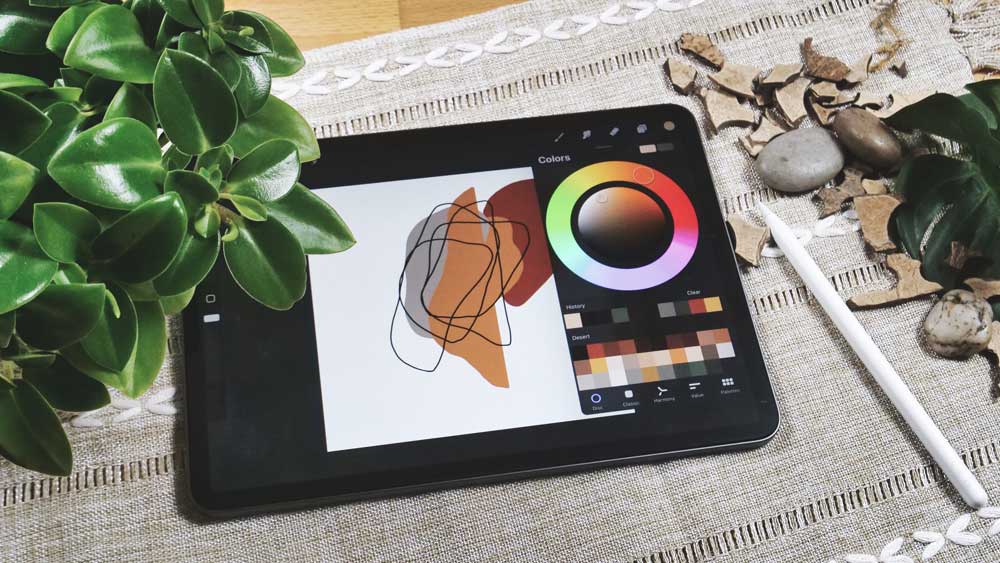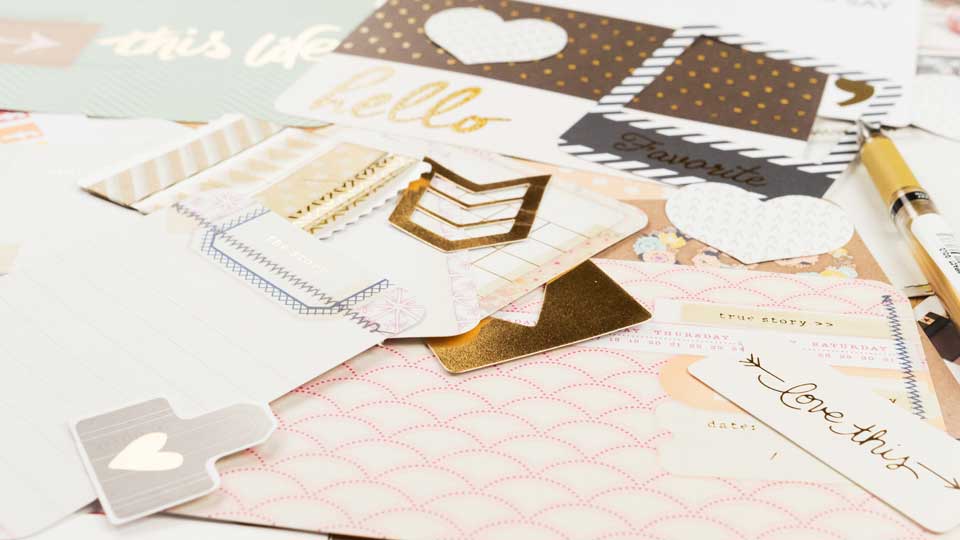Have you ever stood in front of an abstract painting and felt bewildered by its seemingly chaotic composition? You're not alone. Abstract art has been misunderstood and dismissed by many as nothing more than random splatters of paint. But the truth is, abstract art is built on a solid foundation of elements and principles that give it meaning and structure.
In this article, we'll break down the essential elements of abstract art, from color to composition, and I show you how they work together to create something truly unique and powerful. Whether you're an art enthusiast or simply curious about the world of abstract art, this post has got you covered. So buckle up and get ready to explore the fascinating world of abstract art!
Btw - if you wanna get your fingers dirty (or not so dirty on your iPad) you should check out this class where we create an abstract art set - for sale - together:

Create an Abstract Art Set in Procreate
Create your own Clipart in Procreate and turn them into a beautiful digital product!
Color
One of the most impactful elements of abstract art is color. In fact, color is often the first thing that catches our eyes when we encounter an abstract painting. From bold, bright hues to muted, subtle tones, color plays a critical role in setting the tone and emotion of a piece. But color in abstract art is not just about aesthetics. It can also convey meaning and symbolism. For example, red might represent passion or anger, while blue might evoke calm or sadness. The combination of colors can also create contrast and balance within a composition. As we move on to explore the element of line, remember to pay attention to how color is used and what it might be communicating to you and how you feel about it.
Line
In abstract art, line is a powerful tool for expressing movement, direction, and emotion. A line can be thick or thin, straight or curved, jagged or smooth. It can be used to define shapes and forms or create a sense of depth and texture. The placement and direction of lines within a composition can also convey a sense of movement and energy or create a sense of calm and peacefulness.
Just like color, lines can also carry symbolic meaning in abstract art. For example, a horizontal line can represent stability and peace, while a diagonal line might suggest movement or tension. A vertical line can convey a sense of strength or authority.
As you study abstract art, pay attention to how lines are used and how they contribute to the overall meaning and emotion of a piece. Are the lines sharp and angular, creating a sense of tension? Or are they soft and curving, suggesting a more calm and gentle mood? How do they come together with the colour used?
Texture
Moving beyond color and line, the element of texture is another important aspect of abstract art. Texture can be created in a variety of ways, from thick, heavy brushstrokes to delicate, wispy lines. It can be smooth and polished or rough and gritty. Texture can create a sense of depth and dimension, inviting the viewer to imagine what it might feel like to touch the surface of the painting.
As you examine abstract art, pay attention to the textures that are created and how they contribute to the overall mood and meaning of the piece. Are the textures rough and chaotic, suggesting disarray and confusion? Or are they smooth and tranquil, conveying a sense of calm and balance?

Do you like the Artwork? You can find it in my store.
Texture to elicit Emotions and Sensations
Artists use texture as a tool to create tactile sensations in their work, urging the viewer to contemplate the piece from a sensory point of view. The variation in texture, from thick and heavy brushstrokes to thin and delicate lines, can elicit different emotions and sensations. Some textures may create a sense of depth, while others bring out a flatness in the artwork.
When looking at abstract art, observe the textures that the artist has created and think about their contribution to the piece's overall meaning and mood. Rough and chaotic textures might give the impression of disarray and disorder, while smoother textures can create a more calming, balanced effect. Texture is a way for artists to communicate with their audience beyond the visual realm, encouraging them to imagine what it might be like to touch or feel the work's surface.
Considering texture leads us into the next element of abstract art: shape.
Shape
Shape is another essential element to consider when analyzing abstract art. As opposed to representational art, abstract art is not concerned with depicting recognizable forms. Instead, it uses shapes and forms to create an overall abstract composition. Shapes in abstract art can be geometric or organic, depending on the artist's preference. They can be simple or complex, and they can overlap or intersect with one another.
The use of shape in abstract art can evoke different emotions and reactions from the viewer. Angular shapes might create a sense of tension or energy, while rounded shapes can convey a softer, more tranquil mood. Similarly, the size and placement of shapes can affect how a piece is perceived. Larger shapes might dominate the composition, while smaller shapes might add interest and depth.
Understanding how shape is used in abstract art can help you appreciate the artwork on a deeper level. By analyzing the types of shapes used, their sizes, and their placement, you can gain insight into the artist's intentions and the emotions they are trying to convey.
Considering texture and shape are crucial steps in breaking down the elements of abstract art. Texture can add depth and emotion to a piece, while shape creates an overall abstract composition. By understanding these elements, you can begin to appreciate the artwork on a more meaningful level. Next, we will delve deeper into the element of composition and its importance in abstract art.
Composition
Composition is an essential element in abstract art that determines how the individual elements interact to create a unified whole. It involves the arrangement and placement of shapes, colors, lines, and textures to evoke emotions, express ideas, or convey a message. The composition of an abstract artwork may seem random or chaotic, but it is a deliberate effort by the artist to create balance, harmony, or tension.
One of the key aspects of composition is the use of negative space. Negative space refers to the area around and between the shapes in a piece of art. It can create a sense of fluidity, movement, or depth. Artists use negative space to guide the viewer's eye and create a visual hierarchy of elements. By leaving certain areas empty or filling them with contrasting colors or textures, the artist can create a sense of tension or balance in the composition.
Another essential element of composition is the use of color. Color can evoke emotions, express moods, and create a sense of harmony or discord. Artists use color contrasts to emphasize certain elements or create a focal point. By using complementary colors, analogous color schemes, or monochromatic color palettes, artists can create a sense of unity or diversity in the composition.
The placement of shapes is also critical in abstract art composition. The artist can use different sizes, shapes, or angles to create movement, depth, or contrast. The arrangement of shapes can create a focal point or lead the viewer's eye to different parts of the artwork. By overlapping shapes or using asymmetrical balance, artists can create a sense of tension or visual interest.
In conclusion, the composition is an essential element of abstract art that involves the deliberate arrangement and placement of shapes, colors, lines, and textures. By using negative space, color contrasts, and the placement of shapes, the artist can create a sense of balance, tension, or harmony. Understanding the composition of abstract art can help you appreciate the artwork on a deeper level and gain insight into the artist's intentions and emotions.,
Shapes, Lines, Colours & Compositions
Abstract art may seem chaotic at first glance, but the truth is that it is structured on fundamental elements and principles that make it as meaningful as any other type of art. From the bold use of color to the intricate lines, textures, and shapes, each element is integral to the success of the piece. By breaking down the elements of abstract art, we can gain a new appreciation for its vibrancy, subtlety, and range of emotions and experiences. Whether you're an artist or an art lover, understanding these principles can help you create or appreciate other forms of art more deeply. So why not take a chance to delve into the world of abstract art, explore its elements, and discover the beauty within? As Wassily Kandinsky said, "Color is a power which directly influences the soul."
Beside that, creating abstract art yourself can be an outlet for your emotions as well.
The Benefits of creating Abstract Art for Yourself
Creating abstract art as an artist can be truly satisfying. After all only you know the true meaning of your artwork. People who enjoy looking at it can interpret it for themselves which makes it, in my eyes, even more valuable. And because of that I believe that creating abstract art can reach people on a deeper level and make them think - no matter if you want them to think in this direction or not.
I guess that's why I enjoy creating abstract art.
Here is one I consider as abstract art but we can argument about that, I guess it's something in the middle between abstract art and figural painting:

I like creating art like this because it is open enough for people to interpret something and to have a meaning for them and, at the same time, abstract enough to let me create it without going into too much detail.
If you like abstract art like this you can create it yourself, for your own home, friends and of course also for sale. There are many well-known artists on sites like Etsy who produce artwork like this and sell a lot each and every day!

Safari Lounge Designer Classes
Learn everything you need to know to build a sustainable Business for Printable Products. Let's create and plan your business together, and then: market your products. It's all there,
personal coaching included! In case you just wanna have fun - that's inside as well!
